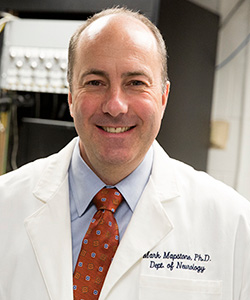
Lives of Consequence
Dr. Mark Mapstone '89

Associate Professor of Neurology, University of Rochester Medical Center
Current measures to identify “biomarkers” for Alzheimer’s disease involve expensive brain imaging, or require removing fluid from the spine through a lumbar puncture, which has risks and is uncomfortable. But a new study led by Dr. Mark Mapstone ’89, associate professor of neurology at the University of Rochester Medical Center, might offer an alternative.
“A blood test could be used more broadly, something like how we routinely measure blood cholesterol levels,” explains Mapstone.
“We have no cure for Alzheimer’s disease, and we have no disease modifying therapies,” says Mapstone. “Early detection of the disease is a priority for developing new treatments because it may lead to insights about the initial biological changes that might be more amenable to treatment before the condition gets too far.”
Alzheimer’s not only progresses in individuals; it’s advancing across society. “The scale of the epidemic is unprecedented,” Mapstone says. “In 2013, more than five million Americans were living with Alzheimer’s disease, and it cost over $215 billion to care for them. Without disease modifying therapy, there are projected to be 16 million patients by 2050. The annual cost of care will be a staggering $1.2 trillion.”
Mapstone and his colleagues went searching for clues on a micro scale, looking for the building blocks of cells themselves. These molecules are some of the smallest that can be picked up in the blood by instruments, on the order of 3 nanometers (3 billionths of a meter) in size.
In the study -- “Plasma phospholipids identify antecedent memory impairment in older adults” published in Nature Medicine in March 2014 -- they followed a group of 525 older adults for up to five years in hopes of finding a marker of the earliest biological changes of Alzheimer’s. The researchers collected blood samples and gave the subjects memory tests each year to see if their memories changed.
Over that span, a number of subjects developed Alzheimer’s. In their blood, Mapstone and his team found a group of 10 small molecules called lipids that were depleted in the people who would go on to develop the disease up to five years before they developed the symptoms.
“We think the changes in these lipids reflect the early loss of cells in this neurodegenerative diseases,” he says. “When we used these 10 lipids to predict who would get Alzheimer’s disease in another group of subjects, the prediction was over 90% accurate.”
Mapstone credits the group for the discovery. “Modern science is a team sport,” he says. “We had neurologists, neuropsychologists, nurses, laboratory biologists, statistical and methodological experts, and a large group of motivated study subjects.”
He learned that teamwork early in life. The oldest of four children, all HWS alums -- Craig ’91, David ’93, and Lesley ’96 -- Mapstone says, “Our parents Jeff and Linda were very involved in our lives and a constant source of encouragement and inspiration. We were taught to be respectful, be team players, and see value in everyone’s contributions.”
At HWS, Mapstone majored in psychology and minored in anthropology. He played rugby and football and was a resident adviser and member of Delta Chi. He also spent a semester at Trinity College in Dublin. Recalling what drew him to HWS, he says, “My first visit to campus was one of those beautiful spring days when everyone was out on the Quad throwing Frisbees and lacrosse balls. There was music coming out of a window in Medbery Hall. I knew it was the place for me.”
Mapstone earned his master’s in psychology from Boston University and his Ph.D. from Northwestern University Medical School. At a research lab at the Massachusetts Institute of Technology, he studied memory in patients with neurological diseases, which go him hooked on clinical neuropsychology.
Alzheimer’s will put that passion to the test. “Alzheimer’s is a devastating disease not only for the individual patient but for families, friends, and society as a whole,” Mapstone says. “Our main goal is to use early detection to understand the underlying biology and discover or develop treatments.”
